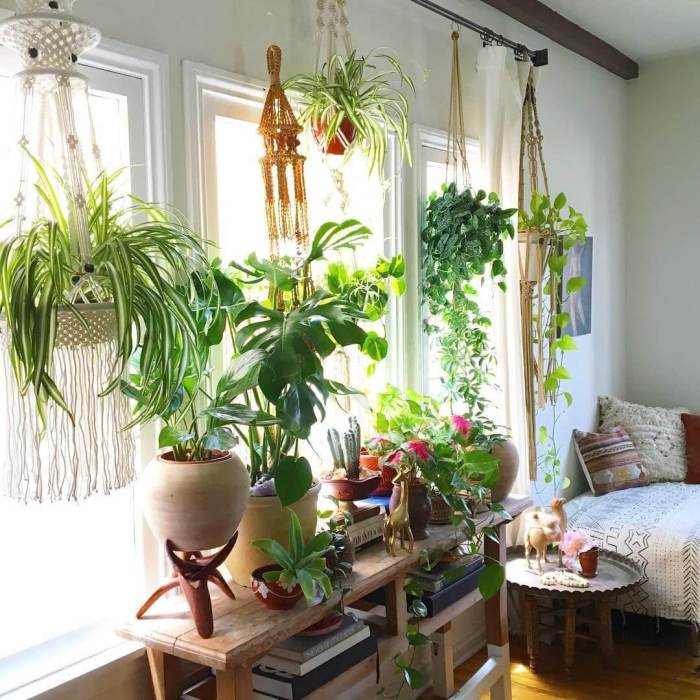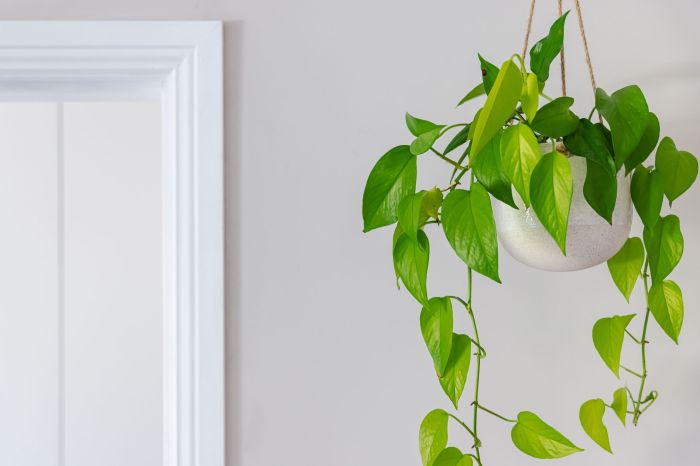Best indoor hanging house plants offer a unique way to bring nature indoors, enhancing air quality, reducing stress, and adding a touch of beauty to any space. From trailing vines to cascading ferns, there’s a perfect hanging plant for every home and lifestyle.
Whether you’re a seasoned plant enthusiast or just starting your indoor gardening journey, this guide will provide you with everything you need to know about choosing, caring for, and displaying the best indoor hanging house plants.
Identify the most popular indoor hanging house plants
Indoor hanging plants are a great way to add life and color to your home. They can also help to purify the air and improve your mood. If you’re looking for a way to add some greenery to your home, here are the top 10 most popular indoor hanging house plants:
- Spider plant(Chlorophytum comosum): Spider plants are one of the most popular indoor hanging plants because they are easy to care for and can tolerate a wide range of conditions. They have long, slender leaves that can grow up to 2 feet long.
Spider plants also produce small white flowers that add a touch of elegance to the plant.
- Pothos(Epipremnum aureum): Pothos is another easy-to-care-for indoor hanging plant. It has heart-shaped leaves that can be either green or variegated. Pothos can tolerate low light conditions and is a good choice for beginners.
- Philodendron(Philodendron spp.): Philodendrons are a large group of plants that can be either climbing or hanging. They have heart-shaped or lobed leaves that can be either green or variegated. Philodendrons are relatively easy to care for, but they do require more light than pothos.
- String of pearls(Senecio rowleyanus): String of pearls is a unique and attractive indoor hanging plant. It has long, trailing stems that are covered in small, bead-like leaves. String of pearls is a relatively easy-to-care-for plant, but it does require bright light.
- Burro’s tail(Sedum morganianum): Burro’s tail is a succulent plant that has long, trailing stems that are covered in small, fleshy leaves. Burro’s tail is a relatively easy-to-care-for plant, but it does require bright light and well-drained soil.
- Hoya(Hoya spp.): Hoyas are a group of flowering plants that can be either climbing or hanging. They have thick, waxy leaves that can be either green or variegated. Hoyas are relatively easy to care for, but they do require bright light and well-drained soil.
- Peperomia(Peperomia spp.): Peperomias are a group of small, compact plants that can be either upright or hanging. They have thick, fleshy leaves that can be either green or variegated. Peperomias are relatively easy to care for, but they do require bright light and well-drained soil.
- Fittonia(Fittonia spp.): Fittonias are a group of small, colorful plants that can be either upright or hanging. They have thin, delicate leaves that are often variegated. Fittonias are relatively easy to care for, but they do require high humidity and well-drained soil.
- Ferns(Filicales): Ferns are a group of non-flowering plants that can be either upright or hanging. They have delicate, feathery leaves that can be either green or variegated. Ferns are relatively easy to care for, but they do require high humidity and well-drained soil.
For those seeking to elevate their indoor gardening, consider the best indoor hanging house plants. These vibrant additions bring life and greenery to any space. However, to ensure their optimal growth, invest in a best hanging grow light . This specialized lighting provides the necessary spectrum and intensity for thriving indoor plants, enhancing their health and beauty.
With the right grow light, your hanging houseplants will flourish, creating a vibrant and thriving indoor oasis.
- Air plants(Tillandsia spp.): Air plants are a group of epiphytic plants that do not require soil to grow. They have long, narrow leaves that can be either green or variegated. Air plants are relatively easy to care for, but they do require high humidity.
Discuss the benefits of having indoor hanging house plants

Incorporating indoor hanging house plants into your living space offers a multitude of advantages, ranging from enhanced air quality to improved mental well-being.
Studies have demonstrated that indoor plants effectively purify the air by absorbing harmful pollutants, including formaldehyde, benzene, and trichloroethylene. This air-purifying capability helps create a healthier indoor environment, reducing the risk of respiratory issues and allergies.
Reducing stress and boosting mood
The presence of indoor plants has been linked to reduced stress levels and improved mood. Studies have shown that interacting with plants, such as watering, pruning, or simply observing them, can induce a sense of relaxation and reduce anxiety. Additionally, the vibrant colors and textures of plants can create a calming and inviting atmosphere in your home.
Share tips for choosing the right indoor hanging house plants

When choosing indoor hanging house plants, consider the following factors:
-
-*Light conditions
Determine the amount of natural light available in the area where you plan to hang the plant. Some plants, like ferns and pothos, can tolerate low light conditions, while others, like orchids and succulents, require brighter light.
-*Humidity
Some plants, like ferns and air plants, prefer humid environments, while others, like succulents and cacti, can tolerate dry air. Consider the humidity level in your home and choose plants that are adapted to those conditions.
-*Space availability
Measure the space where you plan to hang the plant and choose a plant that will fit comfortably without overcrowding the area. Consider the plant’s size, shape, and growth habits when making a selection.
Size and shape
Consider the size and shape of the plant in relation to the space where you plan to hang it. Smaller plants, like spider plants and trailing begonias, are suitable for small spaces, while larger plants, like trailing philodendrons and hanging baskets, are better suited for larger areas.
Growth habits
Some plants have a trailing growth habit, while others grow more upright. Trailing plants, like ivy and wandering Jew, are ideal for hanging baskets or shelves, while upright plants, like snake plants and ZZ plants, can be hung from the ceiling or placed on a high shelf.
For those seeking to enhance their indoor spaces with greenery, hanging house plants offer a versatile and stylish solution. Among the best indoor hanging house plants, trailing vines add a touch of elegance and freshness. Explore a wide range of best hanging vine plants indoor , including varieties like English ivy, Swedish ivy, and spider plants, to find the perfect complement to your home décor and air quality.
Explain how to care for indoor hanging house plants

Indoor hanging house plants add a touch of beauty and freshness to any home. But like all plants, they need proper care to thrive. Here’s a detailed guide on how to care for indoor hanging house plants, including watering, fertilizing, and pruning.
Watering
Watering is one of the most important aspects of caring for indoor hanging house plants. The frequency of watering will vary depending on the type of plant, the size of the pot, and the humidity of the environment. A good rule of thumb is to water when the top inch of soil is dry to the touch.
For those seeking to enhance their indoor spaces with natural beauty, consider the allure of best indoor hanging house plants. These verdant wonders not only add a touch of greenery but also purify the air, creating a healthier and more inviting atmosphere.
For a comprehensive guide to the best house plants hanging, including expert recommendations and care tips, visit best house plants hanging . Discover the perfect hanging plants to complement your home decor and bring a touch of nature indoors.
When watering, make sure to water the plant thoroughly until water drains out of the drainage holes. Avoid overwatering, as this can lead to root rot. If you’re unsure whether your plant needs water, it’s always better to err on the side of caution and wait a few days before watering again.
Fertilizing
Fertilizing is another important aspect of caring for indoor hanging house plants. Fertilizing provides plants with the nutrients they need to grow and thrive. A good quality liquid fertilizer can be used once a month during the growing season (spring and summer).
Be sure to follow the instructions on the fertilizer label carefully.
Pruning
Pruning is an important part of caring for indoor hanging house plants. Pruning helps to remove dead or damaged leaves, encourages new growth, and keeps the plant looking its best. When pruning, use sharp, clean shears to make clean cuts.
Prune back stems to just above a leaf node.
Common Problems, Best indoor hanging house plants
Indoor hanging house plants can be affected by a variety of common problems, including pests, diseases, and nutrient deficiencies. Pests can be controlled with insecticidal soap or neem oil. Diseases can be treated with fungicides. Nutrient deficiencies can be corrected by fertilizing the plant with a balanced fertilizer.
Create a Design Guide for Using Indoor Hanging House Plants
Incorporating indoor hanging house plants into your home decor can transform the ambiance and add a touch of nature’s beauty. Whether you seek to create a vertical garden, enhance a corner with greenery, or divide a space, these versatile plants offer endless design possibilities.
Hanging Techniques
- Ceiling Suspension:Suspend plants from the ceiling using hooks or macrame hangers for a dramatic vertical display.
- Wall Mounting:Mount planters directly to walls using brackets or shelves to create a lush green wall or accentuate empty spaces.
- Shelf Placement:Arrange hanging plants on shelves or bookcases to add height and greenery to your living spaces.
Concluding Remarks

With proper care and attention, indoor hanging house plants can thrive for years, adding life, color, and freshness to your living spaces. Embrace the beauty of nature and create a serene and inviting atmosphere in your home with these enchanting plants.
Common Queries: Best Indoor Hanging House Plants
What are the most popular indoor hanging house plants?
Some of the most popular indoor hanging house plants include pothos, spider plants, philodendrons, ferns, and ivy.
How do hanging plants benefit indoor air quality?
Hanging plants can help improve indoor air quality by absorbing pollutants and releasing oxygen.
What factors should I consider when choosing an indoor hanging house plant?
When choosing an indoor hanging house plant, consider factors such as light conditions, humidity, space availability, and your personal preferences.